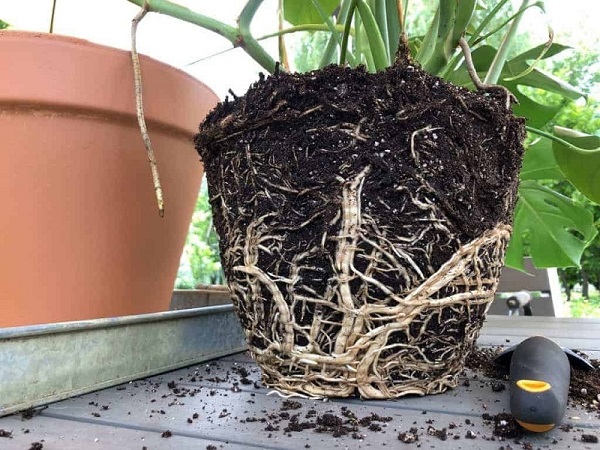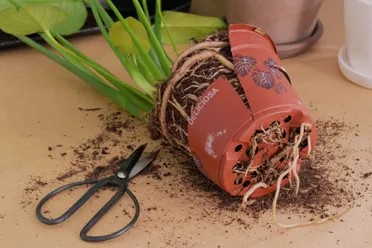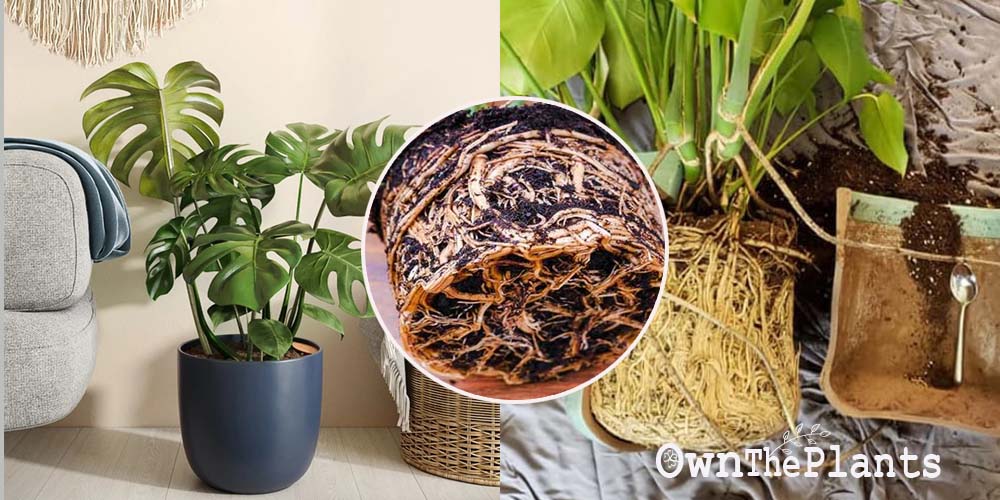It is always a delight to see Monsteras with lush foliage sprawling out of their pots in any gardens or homes. The bigger, healthier, and bushier the leaves, the more dashing a plant becomes.
Leaves, as we all know, are a plant’s crowning glory. But what about the roots?
Have you ever had time to stop and think about what happens to the roots of your Monsteras when they sprawl out of their pots?
Do these tropical plants also need more space for their roots? What happens if they are still stuck in the pots they have overgrown?
In this article, we will show you how to determine if your Monstera is already root-bound.
We will also list down all that you should do in order to alleviate some of the plant problems brought by root-bound Monstera plants.
What Does Root Bound Mean?

A Monstera that is root-bound is one whose root system is so extensive that it has completely filled its pot.
It has grown excessively large that its container is no longer sufficient for its growth. Its roots snarl and tangle and take up all the space available, depleting nutrients and water.
When your Monstera is root-bound, it means the roots are so compacted that they are already squeezed to form a solid, single mass.
This is unhealthy for Monsteras because they will have a hard time absorbing water. In this condition, water may just soak in or drain away quickly.
How Do You Know That Your Monstera Is Root Bound?
Monsteras are known to prefer being somehow root-bound. They have been adapted to thrive in packed-out areas, however, there is always a point when having extremely excessive roots is no longer beneficial for them as it reduces their functionality.
Here are some signs you should look out for to determine if your Monstera plant is already root-bound:
Roots Growing Out of Drainage Holes

It is common to see roots growing out of drainage holes in search of necessary water and nutrients.
However, having extensive roots is a double-edged sword as it also means there are no spaces left for the plant roots to breathe.
If you ever start to observe peeking roots out of the pots, do not take it lightly, as it can also mean a bad thing for your Monstera plant.
Roots Growing Above Ground
Like peeking roots out of the container, when your plant also shows roots above the ground, it also means the plant is seeking out more space.
The room in your pot is not enough for the plant; hence, the roots grow upward above the ground.
The roots peeking above the ground mean that there is no more room in your pot. No sufficient room means more compact, less oxygenated soil – which is really not a good combination for your plants.
Leaf Curling or Wilting
One major drawback for root-bound Monsteras is the loss of ability to absorb water from the ground.
Since the roots are compactly pressed with one another, there is a lesser surface area of the roots to absorb moisture. This causes stress to plants as well.
When roots do not function the way they are supposed to, dehydration occurs. The leaves will eventually become curled or wilted.
Water is not just important for the biological functions of plants, but it also helps maintain its structure and turgidity.
A root-bound Monstera loses the ability to keep its turgor pressure. With constant evaporation and transpiration happening on its body without replenishment of moisture, the plant’s structure will eventually collapse. Curling and wilting is a manifestation of this problem.
You might also like: Why Are My Chinese Evergreen Leaves Curling? (8 Causes + Fix)
Growth Halts
If your Monstera plant is left to be root-bound, you can’t expect to see new growths.
If it does grow at all, a root-bound plant will eventually have a stunted, misshapen, or slow growth compared to the normal rate.
Growth stops in a root-bound plant because the minerals and nutrients essential for growth are not being absorbed efficiently by plants.
These nutrients are just left in the growing medium, which is flushed eventually by water.
Without absorbing nutrients, nutrient deficiency will surely occur in your plants. Your Monstera will have poorly formed and small leaves instead of the lush evergreen ones.
How Do You Check Your Monstera Roots?
If you want to inspect your Monstera roots to see if they still fit the pot, there are proper ways to do it to ensure the roots are not damaged.
The roots are fragile, so mishandling them can severely damage the plant.
To inspect the roots, you must water your plant first and ensure the roots are wet. Dry, crispy roots are easily damaged because they are more fragile than wet roots.
Water your plant at least a day before you schedule to inspect.
The second step would be to check the drainage holes for peeking roots. If you see roots tangling their way out via the drainage holes, snip them so that you can easily get the plant out from the pot.
Carefully remove your Monstera plant from the pot by tapping the sides of the pot to loosen out the single mass of roots.
You can skip this step if you’re using plastic or ceramic pots since plants easily slide out of these materials. Textured pots such as stone or terracotta require more effort.
Once the plant is out, observe the roots closely. Do not be mistaken for moderate root bounds as they are common to Monsteras and are not dangerous for the plant.
Look for those which appear more like compact noodles with less to no dirt visible.
Do Monsteras Prefer to Be Root Bound?
Generally speaking, Monsteras thrive in small spaces. They have already adapted well to live in tree trunk crevices and rocks in the wild.
Their climbing roots are efficient in confined areas, hence they somehow can thrive even when root-bound.
However, as said before, extremely root-bound Monsteras are stressed plants. Observe your Monstera if they still get enough fertilizer and water.
If you see no signs of any stress, you can leave your Monstera in its pot for a much longer time.
Do Monsteras Prefer Small Spots?
Monsteras are aggressive climbers; hence, they really do not care that much about the size of containers they are planted in.
They much prefer to climb or crawl instead of burying themselves in the soil with a compact root network.
It is safe to say that their strong roots are meant to climb a wall or a huge tree. Even the giant Monstera, Monstera deliciosa, thrives in a climbing environment than being stuck under the soil.
No matter the size of the pot, they prefer to grow vertically rather than spreading under ground.
Monsteras thrives in slightly smaller pots than the average size. They are contented and happy as long as they still have space to grow.
Once they outgrow their pots and become root-bound, it’s the time for you to repot them.
How Do You Repot Root-bound Monstera?
Repotting your Monstera plants is simple and straightforward, but there are certain tips that you should consider when doing it to avoid problems.
The size of the pot, growing medium, and proper repotting method must be well thought of.
To successfully repot your root-bound Monstera, consider the methods below:
- Water your Monstera a day before you repot it for root inspection. Moistened roots are more sturdy than dry roots.
- Trim down the errant roots first before tapping out your Monstera to release it from its pot. Loosen your Monstera root mass with utmost care. Rinse any excess soil with clean water.
- Choose the proper pot size and growing medium for your Monstera.
- If you decide to use a moss pole or stake, secure it in place and tie your Monstera plant to it if necessary.
- Water your Monstera thoroughly and let it drain before placing it back to its original location.
Choosing Pots
As for the size of the pot, you will need a pot that is not more than two inches wider at the top compared to the old one.

The new pot must also have a minimum of three drainage holes, as Monsteras do not want waterlogged soil.
Remember that the more drainage holes, the better.
Growing Medium
The growing medium is an important aspect when repotting your plant. You will need more medium to cover your bigger plant.
Because your Monstera wants an airy, rich mix, consider mixing your soil with other organic materials.
The best growing medium mix for Monstera is the one that’s well-draining, light, rich, and chunky.
This type of mix not just promotes root growth but also keeps your plant well-aerated and well-moistened.
You can add peat or sphagnum moss, perlites, coco coir or chunks, and pumice to your soil.
How to Keep Monstera From Getting Root Bound?
Getting root-bound plants are inevitable, especially for aggressive growers such as your Monsteras.
As plant enthusiasts, this is but a common occurrence in gardens that you will expect to deal with for the rest of your plant journey.
To keep your Monstera plants from getting root-bound, it is always best to repot it on time.
Once a year repotting is the ideal frequency, especially for younger, actively growing plants.
Older plants, however, require less repotting. They can be repotted every two to three years.
Final Thoughts
The roots of your Monstera plants also spread as much as your leaves, maybe even more extensively. Your Monstera will eventually become root-bound when left in its pot for a very long time.
Extensive roots may signify healthy growth, but excessive roots can also become detrimental to plants.
Like we humans, when your plant outgrows its current place, it is best to repot it in a bigger place to allow it to reach its maximum potential.
Remember that our plants will only grow as much as their environment allows them to.
If you find this article helpful, we would greatly appreciate it if you leave a comment below. Share your own experiences with a root-bound Monstera and let other people know!
